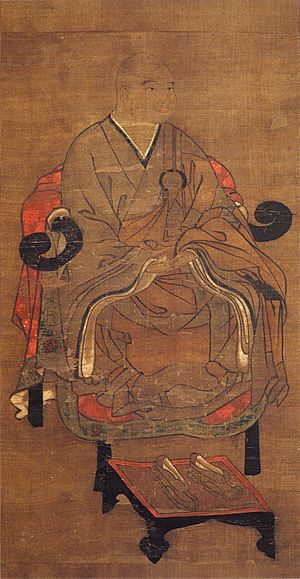Hōjō Tokimune facts for kids
Quick facts for kids
Hōjō Tokimune
北条 時宗 |
|
|---|---|
 |
|
| 8th Shikken | |
| In office 18 April 1268 – 20 April 1284 |
|
| Monarch | |
| Shōgun | Minamoto no Koreyasu |
| Rensho | Hōjō Masamura |
| Preceded by | Hōjō Masamura |
| Succeeded by | Hōjō Sadatoki |
| Rensho | |
| In office 1264–1268 |
|
| Preceded by | Hōjō Masamura |
| Succeeded by | Hōjō Masamura |
| Personal details | |
| Born | 5 June 1251 |
| Died | 20 April 1284 (aged 32) |
| Spouse | Kakusan-ni (daughter of Adachi Yoshikage) |
| Children | Hōjō Sadatoki |
| Parents |
|
Hōjō Tokimune (born June 5, 1251 – died April 20, 1284) was a very important leader in old Japan. He belonged to the Hōjō clan. Tokimune was the eighth shikken, which means he was officially a regent for the shōgun. However, he was the real ruler of Japan during the Kamakura shogunate from 1268 to 1284.
He is famous for two main things. First, he led the Japanese people against the powerful Mongol invasions. Second, he helped spread Zen Buddhism across Japan. Tokimune was the oldest son of Hōjō Tokiyori, who was also a powerful shikken. From the day he was born, Tokimune was prepared to lead his family and Japan. He became shikken when he was just 18 years old.
Tokimune was a strong leader. He held several important titles at once, like tokusō (head of his clan) and rensho (vice regent). During his time, the power of the Japanese Emperor, the Imperial Regent (sesshō), the Imperial Chief Advisor (kampaku), and even the shōgun became much less important. The Hōjō shikken held most of the power.
Contents
Facing the Mongol Threat
When Tokimune became shikken, Japan faced a huge problem. The Mongol emperor, Kublai Khan, sent a message demanding that Japan become a "tributary state." This meant Japan would have to pay money and obey the Mongols, or face an invasion.
Many people in the Japanese government, including some from the royal family, wanted to make a deal. But Tokimune bravely said no to the Mongol demand. He refused to give in to their threats.
Standing Up to Kublai Khan
The Mongols sent many threatening letters and messengers to Japan. This started in January 1268. After talking it over, Tokimune decided to send the Mongol messengers back without any answer.
The Mongols kept sending more messengers. They came in March 1269, September 1269, September 1271, and May 1272. Each time, Tokimune made sure the messengers were sent away. He did not even let them land in Japan.
Soon after, the first invasion happened in 1274. Even after this failed attack, five more messengers arrived in September 1275. They refused to leave without an answer. Tokimune had them brought to Kamakura and then ordered them to be beheaded. You can still see the graves of these five Mongol messengers in Kamakura today.
Then, on July 29, 1279, five more messengers were sent. They were also beheaded, this time in Hakata. Japan knew another invasion was coming. On February 21, 1280, the Imperial Court ordered all temples and shrines to pray for victory. Kublai Khan gathered his troops for another invasion in 1281. This invasion also failed, partly because of a huge storm.
Japan was saved from the Mongols. It was not threatened by invasion again until World War II.
Zen Buddhism and Samurai
Tokimune was very interested in Zen Buddhism. Because of his support, Zen Buddhism became very strong in Kamakura. Later, it spread to Kyoto and all over Japan, especially among the samurai warriors.
In 1271, Tokimune sent a Buddhist monk named Nichiren away to Sado Island. This was because Nichiren's teachings were causing problems.
After the wars with the Mongols, Tokimune focused on his faith. He practiced Zen meditation and built Buddhist temples and monasteries. One famous temple he built was Engaku-ji. It was a memorial to the samurai who had died fighting the Mongols.
When he was younger, Tokimune followed a different Buddhist group called the Ritsu sect. But he changed to Zen before the Mongol invasions. He was so dedicated to Zen that he became a Zen monk on the very day he died.
Zen Guidance for a Leader
The Mongol invasions were stopped by a powerful typhoon, which the Japanese called Kamikaze (meaning "divine wind"). The brave samurai warriors also played a big part. Tokimune planned and led Japan's defense.
Tokimune wanted to be brave and defeat any fear he had. So, he asked his Zen master, Mugaku Sogen, for advice. Mugaku Sogen told him to meditate to find the source of his fear within himself.
When the Mongols invaded, Tokimune went to Mugaku and said, "This is the biggest event of my life." Mugaku asked, "How will you face it?" Tokimune bravely shouted, "Katsu!" which means "Victory!" This showed his strong will to win. Mugaku was pleased and said, "It is true that the son of a lion roars as a lion!"
Because of the victory over the Mongols, and Tokimune's leadership, Zen Buddhism quickly became popular among the samurai class.
Tokimune also connected Zen teachings with the samurai's moral code. This code was later called bushido. It taught samurai to be simple, skilled in martial arts, loyal, and to value "honor unto death." Bushido mixed ideas from Zen and Shinto, adding wisdom and calmness to the warrior's life. Later, under the Tokugawa shogunate, some of these bushido teachings became part of Japanese law.
See also
 In Spanish: Hōjō Tokimune para niños
In Spanish: Hōjō Tokimune para niños

